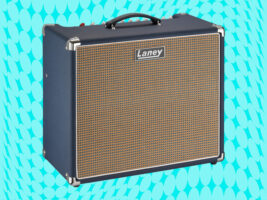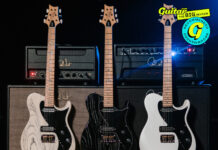
Laney Lionheart Foundry Super 60 review: “It manages to retain the Laney magic without tubes”
$549/£349, laney.co.uk
Much like Laney, the Lionheart model – produced since 2007 – has some serious heritage. First introduced in 2007, it quickly garnered a reputation as a consummate British-sounding single-ended Class A all-tube guitar amp.
READ MORE: Laney Ironheart Foundry Series IRF-Dualtop review: “It’s pretty remarkable you can grab an amp like this for this price”
To the uninitiated, single-ended class A mode means that an amp’s power section is working at full capacity to process the entire signal received from the preamp section, as opposed to a push/pull output stage in which two tubes work together by processing alternate cycles of the input waveform received. Single-ended amps rely less on preamp distortion, instead generating more distortion from the power section resulting in a rich harmonic ‘natural’ overdrive. This amp, however, has no tubes to speak of…
Image: Press
Laney Lionheart Foundry Super 60 – what is it?
The Foundry series is Laney’s solid-state combo range. This means there are no tubes to speak of here, but unlike many affordable amps it’s not digital either – this is a purely analogue solid-state thing. Specifically it’s a 60-watt 1×12 combo with built-in onboard reverb, tremolo, chorus and modulation.
Now, the lack of tubes is something of a problem here because driving the tube output valves – the Lionheart’s calling card – will have little effect on the tone other than its output level.
However, Laney is keen to claim that they’ve faithfully recreated the topology of the tube Lionheart using analogue components to replicate the response of important bits like the tone stack, EQ circuits, and gain stage.
Speaking of gain stages, the architecture of this part is also a little different, as the overdrive level is set prior to the output stage, and with the addition of a boost switch and control knob, that means there’s much more gain available.
One of the downsides of the Class A amp is its relatively low output and greed for power, and whilst the 20-watt Lionheart all-tube amp is likely sufficient for most venues, the powerful 60-watt emanating from the Foundry will comfortably cope with filling the most cavernous of venues.
Conversely, the amp can also be powered down to 1-watt for perfect bedroom volume conditions. If you’re planning on gigging with it, your back will be pleased to know that its hefty output volume does not correspond to physical weight. At 11.5kg it can be lifted by just one finger (not recommended however!).
Image: Press
Laney Lionheart Foundry Super 60 – sounds
My first destination is the dirty channel, of course, and I set the EQ controls to noon and crank the gain. Users of the tube Lionheart or fans of consummate British rock tones will immediately recognise the distinctly familiar tones emanating from the HH 12” speaker. There’s low mid-range aplenty although lacking a little bass, but we address this deficiency not with the EQ control panel, but the tone control which provides a sweeping control of all frequencies.
Although there is plenty of crunch available on Channel 2, engaging the boost control provides a substantial dollop of preamp gain, a little at odds with the power section focus of the Lionheart series, but certainly adding a degree of versatility. The boost control also works on the clean, quickly turning crystal cleans into a raunchier punchy blues rock tone.
The ability to plug straight into your interface is provided via a DI out. Thanks to the additional feature of cabinet emulation, I get an eerily accurate representation of the sound of the combo – it’s arguably one of the most accurate sounding DI outs I’ve heard. A slight downside is that when using this feature, the speaker output is still active but a simple solution to this is to plug in an unconnected jack into the headphone socket and mute the thing.
Like the Ironheart Foundry Series IRF-Dualtop’s spring reverb, the onboard effects are primarily modelled after pedals created by Laney’s Black Country Customs skunk works, and they sound perfectly fine – I can’t imagine anyone’s going to be buying an amp for the built-in effects in 2025, but if this is your first proper amp, these will give a nice rendition of the classics.
Laney Lionheart Foundry Super 60 – should I buy one?
In 2025, accurately emulating a valve amp in either a digital or solid-state format is no longer considered a vaunted accomplishment. However, aside from lower manufacturing costs, there are legitimate advantages to Laney offering their all-tube Lionheart series in this format, including increased headroom, the additional gain from the boost switch, and suite of onboard effects including reverb, chorus and tremolo. It’s therefore quite a bit more versatile than its all-tube inspiration, while its light weight and DI out make it a great companion both onstage and at home.
Image: Press
Laney Lionheart Foundry Super 60 – alternatives
Arguably the most iconic British brand of them all, Vox, has their own range of solid state amplifiers with the 50-watt 1×8 VX50-GTV ($299/£219) not only possessing their famed AC30 digital creation but 10 other amp models and various onboard effects. A very smart-looking option is cream/oxblood version of the Blackstar Debut 50R ($279.99/£235), a solid-state 50-watt combo that delivers rock tones aplenty and, like the Laney, includes a speaker-emulated line-out for recording, with an additional line-in for backing tracks.
The post Laney Lionheart Foundry Super 60 review: “It manages to retain the Laney magic without tubes” appeared first on Guitar.com | All Things Guitar.
Source: www.guitar-bass.net












